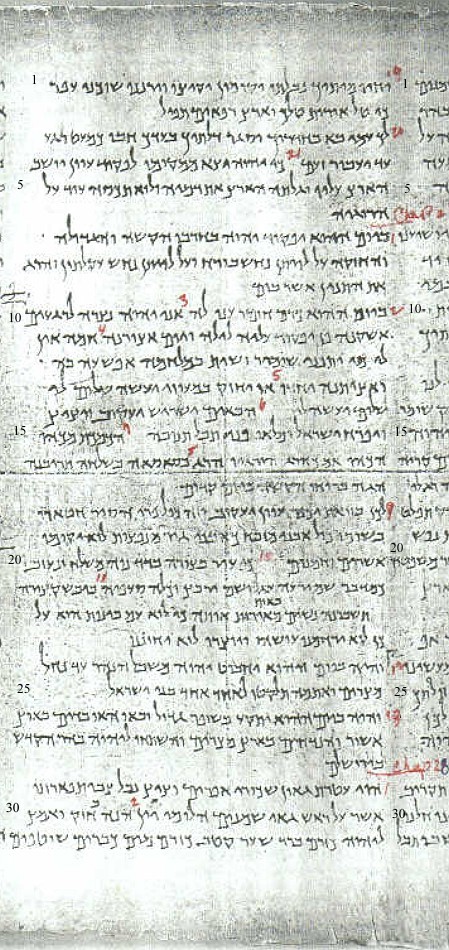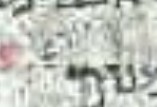
The Great Isaiah Scroll 26:19 to 28:2

Physical Characteristics: This is a very regular page with no blemishes, tears or other problems and every letter is legible.
Paragraphs and spatiums: There are 7 paragraphs marked on this page. More than usual. There are 4 spatiums and one indentation in line 22. New paragraphs begin on line: 3 = 26:20; line 7 = 27:1; line 10 = 27:2; line 18 = 27:9; line 24 = 27:12; line 26 = 27:13; .line 29 = 28::1. The indentation on line 22 does not correspond with any verse nor is there a break in thought at that point. There are spatiums in line: 4 = vs 26:21; line 14 = vs 27:6; line 15 = vs 27:7; line 20 = vs 27 10.
Editorial Mark
There is an editorial mark between lines 23 and 24 in the right margin. This appears to be a one time mark of which there are several in Q. There are also frequently used editorial marks which are discussed in the Introductory page. Go there to see the discussion on editorial marks. Miniature Noatation Along side and above this mark there is what may be a faded miniature notation. See the mark above between lines 23 and 24 and in the figure below which has been digitally enlarged and color enhansed to bring out the faded note. This is one of many such notations in the scroll. See the figure in line 20 commented on this page below Also see other notations described in the Introduction.
Variations in the Q text from the Masoretic.
Line 1: 5th word: Q = "yeqiytsu" 1st stem imp 3mpl. and M = "hiqiytsu" 5th stem imperative 2mpl. 6th word: Q = "va-yaranenu" 1st stem imp 3mpl and M = "va-ranenu" 1st stem imperative 2mpl. (and you will sing)
Line 2: 1st word: Notice "kiy" (because) written without aleph. See Introductory Page on addition of aleph to "kiy" and other particles ending in yod.
Line 4: after 4th word: Q = omission of "hineh" (behold) which is found in M.
Line 10: 4th word: M = "chemed" which is the M text but the translations agree with Q which has "chomer" (red wine).
Line 10: next to Last word and Line 11: 3rd from last word: Q = in line 10 "aniy YHWH natsar-ah" a masc participle + 3fs suf. (I YHWH will nazar her). See my commentary on the importance in Isaiah in using these words as a prophetic "play on words."
Line 13: 2nd word: Q = "yachdav" and M = "yachad."
Line 14: last word: Q = waw conj. not in M.
Line 15: 1st word: Q = "ve-yiphrach" 1st stem imp 3ms and M = "u-pharach" 1st stem perf. 3ms.(and it shall bud)
Line 16: 3rd word: Q has a misspelling. A misplaced waw. The word is "ha-rugayv" (his slain) and Q reverses the order of letters putting waw before resh instead of after resh.
Line 18: last word: Q = chat'ayv" (his sin) noun mpl + suf 3ms and M = "chat'atho" noun fem sing + suf 3ms. This word is a good example of the Q scribe's interchange of waw and yod. What is actually yod waw here is written as waw waw intentionally. This interchange in Q between yod and waw is frequent.
Line 20: Miniature note in the spatium after 2nd word: Digital enhancement of this section of the page shows the appearance of a miniature notation. See the figure enlarged..

All the letters are not clear but the notation contains zayin waw resh and at least one or two more letters. The context would support a note calling attention to female sexual consorts associated with the groves and idols mentioned in this verse. It is possible to see the word "zirmath" a fem. plural of a word meaning a seminal discharge. There are several notations of this type in the scroll that must be enlarged to see. See the most notable of miniature notation on page 35. And see locations of other miniature notation.
Line 22: 3rd word: Q scribe omitted "b'aoth" edited above the line.
Line 24: 6th word: Q = "mi-shibol" and M = "me-shiboleth."
Line 25: 2nd word: Q = "ve-atemah" and M = "ve-atem."
Line 27: 5th word: Q = "ve-histachu" probably a misspelling and M = "ve-hishtachavu" (and they shall worship.)
Line 29: 3rd word: Q = "ga' on" nms (pride) and M = "ga-uth" nfcs (pride).
Line 30: 3rd word: Q = "g'ay" (aleph before yod) and M = "gey' "(aleph after yod). 7th word: Q = "yayin" (wine) which is also the reading in M but Q has an attempted editing over the word. There is little less left than a horizontal stroke (perhaps the remainder of a waw or yod) but erasure (rather than abrasion) under the stroke indicates there was another letter edited here, perhaps the beth 2 words further on. The erasure may have included a whole word edited over this and the next word (yayin hineh) Observe the evidence of erased letters above these words.. 9th word: Q editor added beth (in) to "chazaq" (strong) not in M.
Line 31: 1st word: Q= "le-YHWH" and M = "le-adonay."
Go to next "Q" scroll page Chapter 28:2 to 28:24